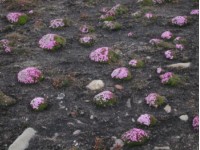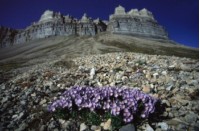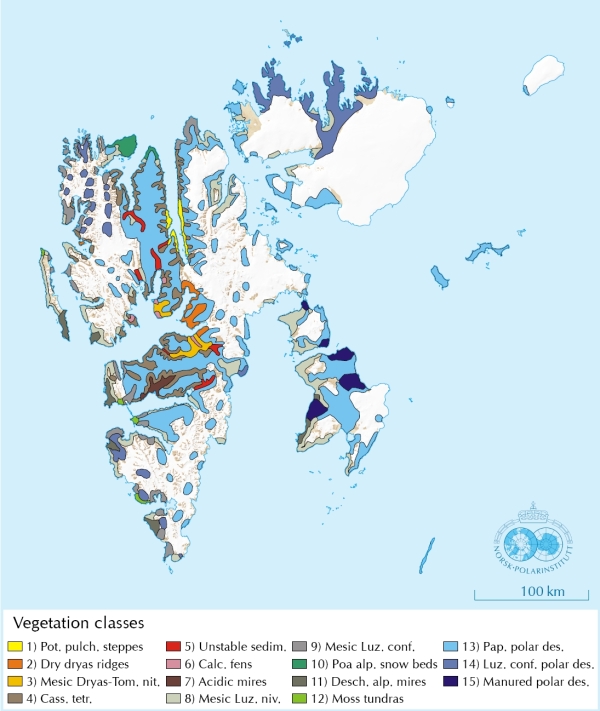The terrestrial vegetation in Svalbard
 Moss Campion is a small plant which grows in dense, hemispherical cushions in Svalbard. It has evolved its own means of taking the best advantage of the sunlight; the flowers on the south side (left in the photograph) of the cushion blossom first because the incoming solar radiation is at its maximum there and then. Later in the season, the flowers on the north side bloom. It is also called the compass plant because the compass direction can be determined if you examine the cushion to see which side flowered first. The cushion shape is also an adaptation to retain the heat better.
Illustration: Arve Elvebakk, Tromsø Museum, University of Tromsø
Moss Campion is a small plant which grows in dense, hemispherical cushions in Svalbard. It has evolved its own means of taking the best advantage of the sunlight; the flowers on the south side (left in the photograph) of the cushion blossom first because the incoming solar radiation is at its maximum there and then. Later in the season, the flowers on the north side bloom. It is also called the compass plant because the compass direction can be determined if you examine the cushion to see which side flowered first. The cushion shape is also an adaptation to retain the heat better.
Illustration: Arve Elvebakk, Tromsø Museum, University of Tromsø
 The beautiful Boreal Jacob's-ladder grows on nutrient-rich soil on the west side of Svalbard, as here on Tempelfjellet. It is quite rare in Svalbard and is found in only one place on the Norwegian mainland. The Norwegian Red List rates it as critically endangered and it is protected in Norway.
Illustration: Odd Harald Hansen, NPI
The growing season in the Arctic is short and hectic, and the low temperatures mean that no trees can grow here; the largest plants in central parts of Svalbard are dwarf shrubs, and furthest north there are no woody plants. Several species have evolved their own tricks to survive the harsh climate. Most of them are perennials so that they avoid having to start each season as tiny seeds. Moreover, as they grow extremely slowly, they might not have the resources to seed and propagate every year, so many species reproduce by runners or brood buds.
The beautiful Boreal Jacob's-ladder grows on nutrient-rich soil on the west side of Svalbard, as here on Tempelfjellet. It is quite rare in Svalbard and is found in only one place on the Norwegian mainland. The Norwegian Red List rates it as critically endangered and it is protected in Norway.
Illustration: Odd Harald Hansen, NPI
The growing season in the Arctic is short and hectic, and the low temperatures mean that no trees can grow here; the largest plants in central parts of Svalbard are dwarf shrubs, and furthest north there are no woody plants. Several species have evolved their own tricks to survive the harsh climate. Most of them are perennials so that they avoid having to start each season as tiny seeds. Moreover, as they grow extremely slowly, they might not have the resources to seed and propagate every year, so many species reproduce by runners or brood buds.
Svalbard is unusual in having the warm ocean currents that also provide support for large bird-nesting colonies. The birds fertilise the ground at the foot of the cliffs, thus providing nutrients for vegetation that can grow there. The bird cliffs in Svalbard are farther north than in many other parts of the Arctic and, due to the cold climate, the vegetation is dominated by mosses, in contrast to herbs and grasses farther south. Moss tundra forms, particularly on the cool coast, and these unbroken carpets provide the ground with such good insulation from heat that the permafrost is found at a depth of only 20-30 centimetres, so that it can actually be touched. These factors make the Svalbard moss tundra outstanding in a global context.
Svalbard is divided into three bioclimatic zones on the basis of the temperature conditions, the middle arctic tundra, the northern arctic tundra and the arctic polar desert. Besides the temperature, many other factors are also crucial for the development of vegetation in Svalbard, such as a long or short snow cover, rich or poor bedrock, stable or unstable substrate, and fertilisation by birds or reindeer. The vegetation map shows the main types of vegetation in Svalbard. The 15 predominant ones that are shown here (the variation is much greater on the detailed scale) actually differ in each of the three bioclimatic zones in the archipelago.
The vegetation types vary greatly in Svalbard, from bone-dry steppes in Wijdefjorden, and almost sterile, gravel-dominated polar desert in the coldest areas, to the tundra landscape close to the settlements. All told, there are some 165 species of higher plants in Svalbard, about 370 species of mosses and about 600 species of lichens. These are high figures in relation to the other groups of species in Svalbard, but nevertheless few compared with the mainland.
Did you know...
 In botany, a hotspot denotes an area where the species diversity is higher than in the surrounding area. This is because the microclimate and/or the bedrock are better just there than in the area around. Such a hotspot is found in Colesdalen, a valley in Isfjorden, where polar bilberry, cloudberry, arctic harebell and dwarf birch grow. These species are not found anywhere else in Svalbard.
In botany, a hotspot denotes an area where the species diversity is higher than in the surrounding area. This is because the microclimate and/or the bedrock are better just there than in the area around. Such a hotspot is found in Colesdalen, a valley in Isfjorden, where polar bilberry, cloudberry, arctic harebell and dwarf birch grow. These species are not found anywhere else in Svalbard.
 The main types of vegetation in Svalbard. Those with yellowish to reddish-brown shades belong in the warmest, middle arctic tundra zone in the fjord districts, those with grey and green shades belong in the northern arctic tundra zone along the coasts and the blue and violet shades belong in the polar desert zone furthest north and east. 1) High-arctic steppes dominated by Tufted Cinquefoil. 2) Dry ridges dominated by Mountain Avens. 3) Mesic (semi-moist) areas dominated by Mountain Avens and Golden Autumn Moss. 4) Areas dominated by White Arctic Bell-heather. 5) Unstable sediments. 6) Calcareous fens. 7) Acidic and nutrient-poor mires. 8) Mesic (semi-moist) areas dominated by Arctic Wood Rush. 9) Mesic (semi-moist) areas dominated by Northern Wood Rush. 10) Snow patches dominated by Alpine Meadow-grass. 11) Mires dominated by Alpine Hair-grass. 12) Moss tundras. 13) Polar desert dominated by Svalbard Poppy. 14) Polar desert dominated by Northern Wood Rush. 15) Bird-fertilised polar desert.
The main types of vegetation in Svalbard. Those with yellowish to reddish-brown shades belong in the warmest, middle arctic tundra zone in the fjord districts, those with grey and green shades belong in the northern arctic tundra zone along the coasts and the blue and violet shades belong in the polar desert zone furthest north and east. 1) High-arctic steppes dominated by Tufted Cinquefoil. 2) Dry ridges dominated by Mountain Avens. 3) Mesic (semi-moist) areas dominated by Mountain Avens and Golden Autumn Moss. 4) Areas dominated by White Arctic Bell-heather. 5) Unstable sediments. 6) Calcareous fens. 7) Acidic and nutrient-poor mires. 8) Mesic (semi-moist) areas dominated by Arctic Wood Rush. 9) Mesic (semi-moist) areas dominated by Northern Wood Rush. 10) Snow patches dominated by Alpine Meadow-grass. 11) Mires dominated by Alpine Hair-grass. 12) Moss tundras. 13) Polar desert dominated by Svalbard Poppy. 14) Polar desert dominated by Northern Wood Rush. 15) Bird-fertilised polar desert.
Illustration: Arve Elvebakk, Tromsø Museum, University of Tromsø, modified by NPI